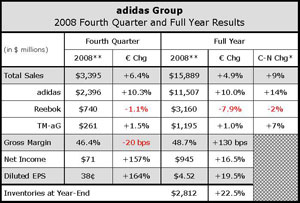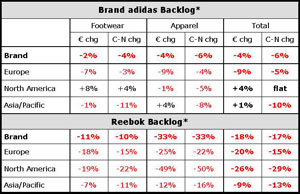It was a bit of the same old tune for adidas Group as it ended another year with a continued sales growth at adidas and TaylorMade-adidas Golf while difficulties at Reebok left that business as a drag to the overall. However, overall group sales still grew for both the fourth quarter and year, with double-digit growth in net income for the year and a quarterly net income that more than doubled.
Though 2008 proved to be a relatively good year for the adidas Group on the income statement, the outlook for 2009 is somewhat murkier. Backlogs were down across much of the board for the brand adidas and Reebok businesses at year-end, though management was quick to point out that the companys growing owned-retail operations and retailers continued push to make orders later in season have left the metric as a less than true barometer of future performance.
For the fourth quarter, adidas Group revenues grew 4% on a currency-neutral basis due to higher sales in the adidas segment. Sales in Europe slipped 2.7% to 889.0 million ($1.17 bn) from 914.0 million and declined 4.7% to 649.0 million ($856 mm) in North America. Those declines were more than offset by a 23.4% jump in Asia/Pacific sales to 787.0 million ($1.04 bn) and a 42.2% surge in Latin America sales to 246.0 million ($324 mm). Asia/Pacific was the second largest for the adidas Group as North America slid to third.

Apparel sales increased 3.6% for the quarter to 1.19 billion ($1.57 bn) as Footwear sales jumped 15.4% to 1.18 billion ($1.55 bn). The growth in Apparel and Footwear for the quarter was somewhat offset by a 16.7% decline in Hardgoods revenues to 204.0 million ($269 mm).
Overall group gross margins declined 20 basis points for the fourth quarter to 46.4% of net sales. However, net income still jumped 157% to 54.0 million from 21.0 million last year partly due to a lowered tax rate. The realization of a book gain of 21 million ($26.5 mm) related to the acquisition of Ashworth, Inc. was partially offset by restructuring costs and other one-time expenses of 7 million ($8.8 mm).
adidas brand net sales jumped 10.3% to 1.82 billion ($2.40 bn) from 1.65 billion ($2.39 bn) for the year-ago quarter. Sales dipped 1.5% in Europe for the adidas brand to 720.0 million ($949.6 mm), but increased 4.4% to 306.0 million ($403.6 mm) in North America.
Asia/Pacific revenues jumped 33.1% for the brand to 623.0 million ($821.6 mm), while Latin America increased 7.9% to 163.0 million ($215.0 mm). Owned-retail revenues actually slid 3.5% for the fourth quarter to 381.0 million ($502.5 mm). For the fourth quarter, gross margins improved 40 basis points for the brand to 47.0% which contributed to adidas brand operating profit jumping 130% to 147 million ($193.9 mm).
For the full year, adidas brand net sales increased 14% on a currency-neutral basis, with footwear, apparel and hardware sales all growing at double-digit rates. Regionally, sales grew in double-digits for the year everywhere except in North America, where sales actually declined. Europe revenues increased 10.0% in euro terms, or 13% on a currency-neutral basis, for the year, to 3.88 billion ($5.71 bn), driven by double-digits increases in emerging markets. North America sales declined 9.9% in euros, or 3% currency-neutral, in North America to 1.15 billion ($1.69 bn) with the company attributing the decline to the difficult retail environment in the U.S.. Asia/Pacific sales jumped 22.7% in euros, or 24% on a currency-neutral basis, to 2.09 billion ($3.08 bn). Latin America also proved strong for the adidas brand, growing 16.2%, or 21% currency-neutral, to 660.0 million ($971 mm).
On a category basis, Sport Performance sales improved 11.4% to 6.25 billion ($9.20 bn) for the year. Sport Performance sales grew 15% on a currency-neutral basis. Running and Football (soccer) grew were “particularly strong,” while Training, Basketball and Originals all saw double-digits growth as well. Sport Style sales increased 5.5% to 1.54 billion ($2.26 bn) with both Originals and Fashion growing. Currency-neutral, Sport Style sales increased 10% for the year.
For the year, adidas brand owned-retail revenues increased 16.5% to 1.43 billion ($2.11 bn). Growth came from new store openings and a mid-singles increase in comparable store revenues. The company increased its store count by 329 during the year to 1,332 doors at year-end.
But Reebok Full Year Declines Are Offset by TMaG and adidas Gains…
The adidas brand store base was comprised of 796 concept stores, 381 factory outlets, 150 concession corners and five e-commerce stores.
Full year gross margins for the adidas brand improved 120 basis points to 48.6% of brand sales, which management said represented the highest annual gross margin for the segment since the companys IPO in 1995. The improvement was primarily attributed to improving regional sales mix as well as increased reliance on owned-retail sales.
For the fourth quarter, Reebok net sales declined 1.1% in euros to 561.0 million ($740 mm). Sales declined in all regions except for Latin America where they were up exponentially to 81.0 million ($107 mm) from 21.0 million ($30 mm) for the year-ago quarter. However, a 400 basis point decline in gross margins to 34.1% of segment sales caused the business to generate an operating loss for the quarter of 9.0 million ($12 mm) after an operating profit of 21.0 million ($30 mm) last year.
For the full year, Reebok sales declined 2% on a currency-neutral basis to 2.15 billion. Management reported that footwear sales were stable on a currency-neutral basis, while hardgoods sales increased. However, apparel sales declined, offsetting the other gains. Sales declined 21.7% in North America for the year to 964.0 million ($1.42 bn). On a currency-neutral basis, sales declined 16% in the region with declines in both the U.S. and Canada. Sales in Europe declined 3% currency-neutral, or 7.6%, when measured in euros to 691.0 million ($1.02 bn). Asia/Pacific was up 7% in c-n terms, but slipped 0.7% in euros to 267.0 million ($393 mm), while Latin America sales jumped 192% currency-neutral and 169% in euros to 226.0 million ($333 mm) for the year.

Brand Reebok sales were relatively stable on a currency-neutral basis, but declined 6% in euros to 1.72 billion ($2.53 bn) as increased Running sales were offset by declines in Lifestyle and “most major sports categories.” Reebok-CCM Hockey sales decreased 6% on a currency-neutral basis and 11% when measured in euros to 188 million ($277 mm), largely due to declines in the licensed jersey business. Rockport sales dropped 10% currency-neutral or 17% in euros to 243.0 million ($358 mm) with management noting particular softness at department stores and mall specialty as factors in the decline.
Reebok owned-retail sales increased 17% on a currency-neutral basis or 8.3% in euro terms to 379.0 million ($558 mm).
The increase was driven by new store openings in emerging markets, especially Russia. Store count at year-end increased by 123 to 647 doors with 253 concept stores and 327 factory outlets.
Reebok segment gross margins decreased 170 basis points for the year to 37.0% of segment sales due largely to lower margin clearance sales in the U.S. and the U.K. The decreased margins and increased operating expenses led to an operating loss of 7.0 million ($10 mm) for 2008 after an operating profit of 109 million ($149 mm) last year.
At TaylorMade-adidas Golf (TMaG), net sales for the fourth quarter increased 1.5% as growth in North America and Asia/Pacific offset European softness. Sales grew to 198.0 million ($261 mm) from 195.0 million ($283 mm) for the year-ago quarter. Operating profit was flat for the segment for the quarter at 24.0 million ($32 mm).
For the full year, TMaG sales increased 1.0% to 812.0 million ($1.19 bn) from 804.0 million ($1.10 bn) last year.
In an exclusive interview with Sports Executive Weekly, TMaG management attributed the increases to broad product category and regional sales growth.
In hardgoods, EVP David Abeles said TMaG grew its business in every category last year with “strong growth” in the companys two largest categories- metalwoods and irons-and high double-digit growth in golf balls and putters. He said the fourth quarter particularly benefited from introductions of the R7 Limited, Burner+ Irons and Itsy Bitsy Spider putter. Abeles noted that growth came from all channels of distribution, with the total door count and the sales mix relatively stable between on-course and off-course shops.
In softgoods, EVP John Kawaja said the company had “a very solid year” as adidas Golf softgoods grew double-digits in revenues. He said growth came from all regions, with Japan and Asia/Pacific growing at the highest rate. Kawaja said Adidas Golf has “significantly more”
than 50% of its revenues from international sales, which provides for terrific opportunities to continue growing the business.”
TMaG Management Upbeat, but Overall 2009 Group Outlook Remains Murky…
“Apparel sales grew at a very fast pace with a CAGR over the last four years in excess of 25%,” Kawaja continued. “Footwear grew considerably, led by two launches in the Tour 360 family with the Tour 360 LTD and Tour 260 3, as well as continued strength in the Powerband franchise.”
Overall segment sales were flat in Europe for the year at 95.0 million ($140 mm), but actually declined 4.0% in North America to 405.0 million ($596 mm). However, on a currency-neutral basis, sales jumped 17% in Europe and grew 3% in North America with growth in both the U.S. and Canada. Currency-neutral sales increased 10% in Asia/Pacific, or 8.2% in euros to 305.0 million ($449 mm), while growing 38% currency-neutral in Latin America or 16.7% in euros to 7.0 million ($10 mm) for the year.
Lower margin sales in metalwoods due to heavy second half promotions in the industry caused overall segment gross margins to decline 40 basis points to 44.3% of segment sales for the year. A one-time book gain from the Ashworth acquisition and the divestiture of Maxfli led to a jump in operating income, which increased 20.0% to 78.0 million ($115 mm) for the year.
Looking to 2009, Abeles was excited about the prospects for TMaG. “We are pretty optimistic about the business starting with the launch of the R9, which just now arrived in stores,” Abeles said. “We expect share gains will be more than significant with this launch. The retailer anticipation and feedback has been as good as or better than with any driver launch weve ever had before.”
For the adidas group as a whole, management expects low- to mid-single-digit sales declines on a currency-neutral basis in 2009. Revenues in the adidas segment are projected to decrease at a low- to mid-single-digit rate on a currency-neutral basis. Reebok segment sales are expected to be “at least stable” compared to the prior year on a currency-neutral basis; and currency-neutral TaylorMade-adidas Golf sales are forecasted to grow at a low-single-digit rate due to the consolidation of Ashworth, Inc.
Group gross margin is expected to decline compared to the prior year as a promotional environment in mature markets, as well as expected higher sourcing costs due to increased raw material and wage costs, in particular in the first half of the year, all have an impact. The Groups operating expenses as a percentage of sales are expected to increase mainly as a result of higher expenses for controlled space initiatives in the adidas and Reebok segments. Consequently, the Groups operating margin and earnings per share are projected to decline.
At year-end, group inventories increased 22.5% to 2.00 billion ($2.51 bn). On a currency-neutral basis, inventories grew 21%. Management said the increase was due to earlier ordering of product for lower prices and hesitant customer order patterns. Inventory ageing, however, improved compared to the prior year.















